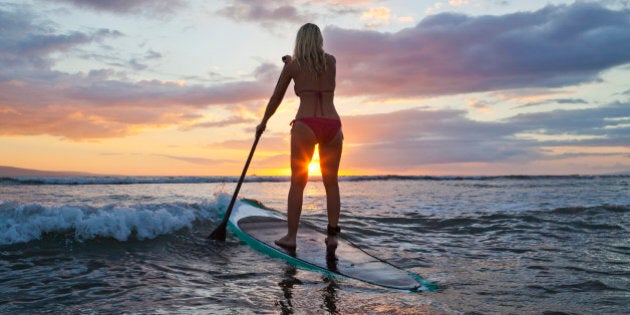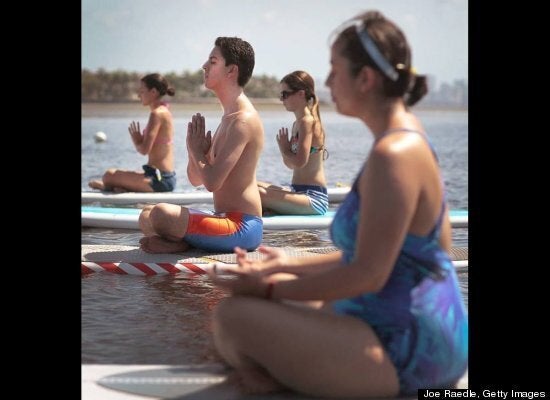
Some of my favourite memories are paddling and laughing with friends. Stand up paddle boarding (SUP) has really taken off in the past few years and it seems now more than ever people are trying this fun outdoor activity.
To find out more about the top tips that anyone can use to start SUP, I spoke with Amy Harris, communications manager at Deep Cove Outdoors and Deep Cove Kayak. Amy shared with me her top tips on how to get started paddle boarding.
Who can try SUP?
Anyone! In lessons, anyone who wants to learn, can -- young people, older people, people who have paddled before and people who have no experience whatsoever! The great thing about SUP is that it is so easy to access and there are boards to fit virtually any person. Boards are available to people ranging from 5' 0" women who weigh 95 lbs up to big beefy guys up to 300 lbs.
What are the five basic tips to start SUP?
1) Make sure you have the right board for your experience.
Talk to anyone in a store that knows their stuff to make sure you're getting the best board for what you want to do. It's no use getting a board that is great for surfing if you're only going to be using it on flat water. If you're renting a board make sure whoever takes your booking knows your experience level and books you onto an appropriate board.
2) Get your gear
Essentials are your paddle, a personal flotation device (PFD) and a leash. With your paddle, lighter is always better -- you want to be tired from paddling, not from holding your equipment. Carbon fibre paddles are pricier, but worth the investment if you intend to use your board for longer.
Only get an adjustable paddle if you need to share the paddle, otherwise the extra weight is not worth it. In terms of paddle shape there are many theories out there, but as long as you stick to a company with a good history of paddle making you can't go wrong.
A personal flotation device is a legal requirement of Transport Canada to wear while out on the water, and you can get ticketed if you're not wearing one. One of the most popular kinds of PFD is an inflatable belt pack which you wear like a fanny pack. It means the PFD doesn't restrict the paddling motion of your arms, and can be deployed if necessary using a toggle. Regular PFD's can be used too, just make sure they fit properly and don't get in the way of your paddling.
Whilst a leash is not a legal requirement, we recommend everyone gets one as you really don't want your board to get away from you, which is surprisingly easy to do, particularly in windy conditions. You can get them to either go around your ankle, your calf or even with a hook attachment to your PFD.
3) Once you're set up with all your gear, stand beside your paddleboard in shallow water. The easiest way to start is on your knees, so put the paddle horizontally across the board just above where the handle is, which is the centre point of the board so is the best place to kneel and stand.
Kneel on the board with your knees either side of the handle and start paddling. Once you are comfortable, stand up, keeping your knees bent which will help with your balance. Keep looking where you're going, and the world is your oyster!
4) A good paddle technique involves leaning forwards to plant the paddle in the water, draw it towards the back of the board keeping it as straight as possible, and take it out of the water when it gets in line with your feet.
Keeping the paddle straight will help keep your board straight but should you find the board turning, take the paddle out of the water, switch hands and paddle on the other side to keep in a straight line.
5) As you become more confident, try moving your feet around a little and keeping your balance. SUPing improves your core strength and balance as you paddle, meaning that the more you do it, the better you get! We find that the learning curve for paddle boarding increases really quickly, so it's easy to improve a lot in a short space of time. Best thing to do - get out, get paddling and have fun!
Do you have to know how to swim to SUP?
You don't have to, although it is probably ideal because it is fairly likely you will fall off your board at some stage so you should at least be confident enough to be able to be in the water until you can get back onto your board. If you cannot swim it is even more advisable to have a leash as well as a PFD.
What are the different types of SUP?
There are boards designed for all sorts of different water conditions: surfing, flat water, touring, downwind wave riding and river being just some of them. The board shapes are quite different for each, so it is important to talk to someone who knows how to advise the best kind of board for you.
What to wear while SUP?
Wear something you don't mind getting wet because falling off your board is a distinct possibility. A lot of people just wear swimwear in the summer, and in cooler conditions there are a number of great companies making paddle wear specifically designed for paddling. There is no such thing as bad paddling conditions, just bad clothing choices. Get the right gear and you can paddle year round no problem, even when it is snowing!
Any other tips?
There are a lot of cheap boards around, which inevitably get damaged and need repairing frequently. Like anything, you get what you pay for, so invest wisely and your board will last you for years to come.
I will continue to enjoy the outdoors and share my experiences. If you have ideas or questions about the outdoors, please leave a comment below and I will do my best to find the answer for you.
Your suggestions are always welcome, as I continue on my journey to enjoy life to the fullest. Let's have the very best 2015!
Visit Sacha daily at SachaD.com
MORE ON HUFFPOST:
